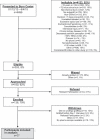Peritraumatic Plasma Omega-3 Fatty Acid Concentration Predicts Chronic Pain Severity Following Thermal Burn Injury
- PMID: 33895836
- PMCID: PMC8737082
- DOI: 10.1093/jbcr/irab071
Peritraumatic Plasma Omega-3 Fatty Acid Concentration Predicts Chronic Pain Severity Following Thermal Burn Injury
Abstract
Chronic pain is a significant comorbidity of burn injury affecting up to 60% of survivors. Currently, no treatments are available to prevent chronic pain after burn injury. Accumulating evidence suggests that omega-3 fatty acids (O3FAs) improve symptoms across a range of painful conditions. In this study, we evaluated whether low peritraumatic levels of O3FA predict greater pain severity during the year after burn injury. Burn survivors undergoing skin autograft were recruited from three participating burn centers. Plasma O3FA (n = 77) levels were assessed in the early aftermath of burn injury using liquid chromatography/mass spectrometry, and pain severity was assessed via the 0 to 10 numeric rating scale for 1 year following burn injury. Repeated-measures linear regression analyses were used to evaluate the association between peritraumatic O3FA concentrations and pain severity during the year following burn injury. Peritraumatic O3FA concentration and chronic pain severity were inversely related; lower levels of peritraumatic O3FAs predicted worse pain outcomes (β = -0.002, P = .020). Future studies are needed to evaluate biological mechanisms mediating this association and to assess the ability of O3FAs to prevent chronic pain following burn injury.
© The Author(s) 2021. Published by Oxford University Press on behalf of the American Burn Association. All rights reserved. For permissions, please e-mail: journals.permissions@oup.com.
Figures



References
-
- Mauck MC, Smith J, Liu AYet al. Chronic pain and itch are common, morbid sequelae among individuals who receive tissue autograft after major thermal burn injury. Clin J Pain 2017;33:627–34. - PubMed
-
- Dauber A, Osgood PF, Breslau AJ, Vernon HL, Carr DB. Chronic persistent pain after severe burns: a survey of 358 burn survivors. Pain Med 2002;3:6–17. - PubMed
-
- Malenfant A, Forget R, Papillon J, Amsel R, Frigon JY, Choinière M. Prevalence and characteristics of chronic sensory problems in burn patients. Pain 1996;67:493–500. - PubMed
Publication types
MeSH terms
Substances
Grants and funding
LinkOut - more resources
Full Text Sources
Other Literature Sources
Medical

